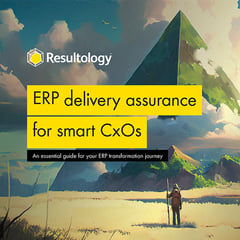The 6 biggest obstacles to your ERP Spec and Select Project
When companies want to upgrade or move to a new ERP most go through a Spec and Select process - outlining their business needs so they can check out how they align to the various products on the market.
The problem is, because Spec and Select is about choosing a product, companies make the mistake of focusing on the product and not themselves.
Despite the fact you’re choosing a product, the majority of the time and effort of your Spec and Select process should be spent thinking about your business, your processes and your business strategy.
When you truly understand your own business strategy and have an open mind to transformation your best-fit software solution will become clear.
So why do companies get it wrong?
Here are the 6 biggest obstacles to an effective Spec and Select.
1. Only paying lip service to the ERP Spec and Select process
While most companies’ procurement departments will require an RFP for projects of this size, it can be the case that IT are only paying lip service to the Spec and Select process - with the IT department already having chosen their preferred solution based on personal history with a product.
This causes big problems.
While most solutions can be bent and broken to fit your requirements, making something work when it isn’t the right fit costs money.
Also, failing to prioritise business requirements puts you in danger of missing out on the transformative benefits of a well thought out ERP implementation.
2. Jumping straight into ERP Selection
As the desired outcome of a Spec and Select is to choose software, businesses can race through the specification process in order to get onto the Select stage.
This is a mistake.
Only by properly understanding your processes and aligning these to your business strategy will your Spec and Select process work.
Resulting’s Boilerplate model for ERP Spec and Select guides you by using a cross industry standard process model (APQC) as a baseline, and a tested set of strategy and architectural questions that will ensure the specification process is thorough.
This helps you put the right amount of focus on your business processes before rushing off to spend a big chunk of company money.
3. Thinking in old ways about ERP
Some IT departments get stuck in a rut, wanting to do things the same way they have before.
This can be down to a number of reasons, from sheer bone idleness to perceived “wisdom” that just isn’t true.
An example of this would be avoiding the cloud because of data protection, when the reality is today’s cloud environments are probably much safer than managing data on prem.
It’s one thing to avoid unproven, bleeding edge technology — but if you’ve not done an ERP upgrade in your business for 10+ years you will miss out on loads of useful tools if you don’t leverage the newest tech.
So how do you decide which innovations to use?
Talking to someone with a broad knowledge of available solutions is a great place to start.
Seeking advice from an independent consultancy (that isn’t affiliated with an SI or any major software vendor) is a good way to explore the products available to you without bias or hard sell tactics.
4. Failing to consider your entire ERP portfolio
Many companies will become guilty of this in oncoming storm of S/4HANA migrations.
If - for example - you are upgrading ECC to S/4HAHA due to the 2025 support deadline, you might be tempted to quickly shift processes from your ECC system to S/4, leaving everything else as it was.
Don’t do it.
Treating it as a simple software upgrade leaves lots of potential for business transformation on the table.
S/4 is more than just an upgrade and it may do things you currently rely on other products or customisation for.
And, this same principal applies to any software decision making - not just moving to S/4.
Always consider your entire product portfolio in any decision making. If you don’t you could miss opportunities to simplify processes, save money, or gain competitive advantage.
So how do you do it?
Make sure your Spec and Select includes a current integrated application architecture review and a full business process master list.
By looking at the whole you will make conscious scope decisions rather than being constrained by your current application scope only.
5. Failing to consider better software options just to have one ERP system
During the Spec and Select process it can be tempting to try and use as few software options as possible, forcing all your business processes into one core ERP.
The problem is, your core ERP might not be able to accommodate some of the key processes that deliver competitive advantage. This would result in either losing competitive advantage or overly customising the ERP to make your processes work.
Rather than customising, it can be better to choose an additional product that can run the process as you need it to for your competitive advantage. This can be a better choice than customising core ERP as it doesn’t create technical debt and it will be supported by the vendor through upgrades for years to come.
In todays’ IT landscape this is particularly relevant as updates are more frequent and are more likely to come with new functionality activated as standard than they used to, making customisation more costly and risky than it once was.
To better understand how to drive competitive advantage through your software choices and create a “best of breed” ERP, download the Resulting Package Portfolio Matrix.
6. Not being open to business transformation as part of ERP implementation
Before you even begin thinking about choosing your product you need to make sure your business activity is aligned to your business strategy.
Your strategy will focus on increasing revenue or market share, improving customer satisfaction and / or retention, or on improving internal process efficiency.
Aligning to this strategy could mean developing new areas of the business, internal restructuring, the creation of new teams, process standardisation, centralising or decentralising, expanding into new markets, and even relocating.
IT, ERP and data analytics are a supporting part of this journey, but they should not be the driver of change.
By starting the business transformation process before you choose your products, product selection and delivery will become easier.
Process standardisation is key to successful implementation, as is a consistent understanding of your main business drivers.
The areas where value is most likely to be driven, where your competitive advantage lies, are the areas that should drive your selection - as these are the areas where you will deliver on your business strategy.
And, any decisions you make that don’t align to or benefit your business strategy are the wrong decisions to be making - including your choice of ERP products.
If you need help with ERP Spec and Select, Boilerplate is the place to start - it’s our unique process for ERP Specification and Selection.











